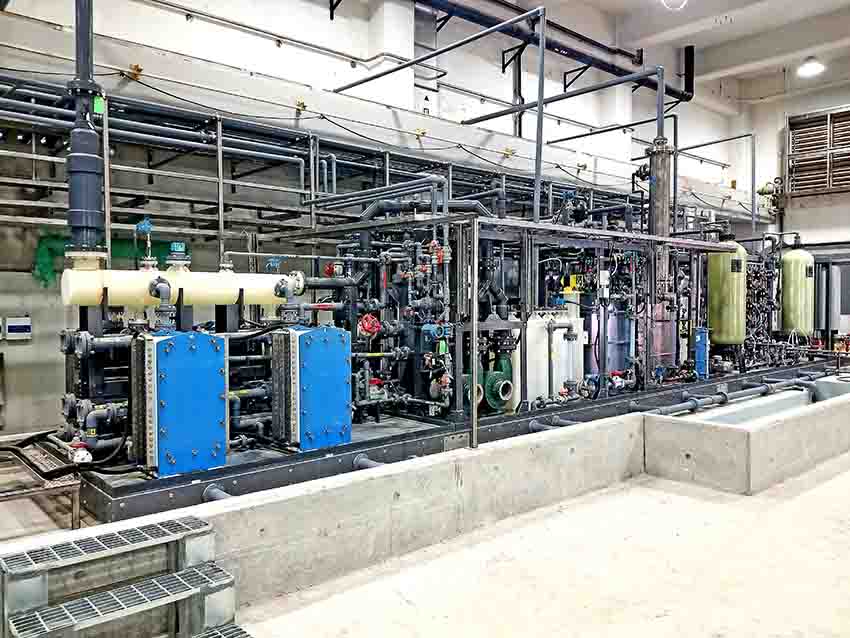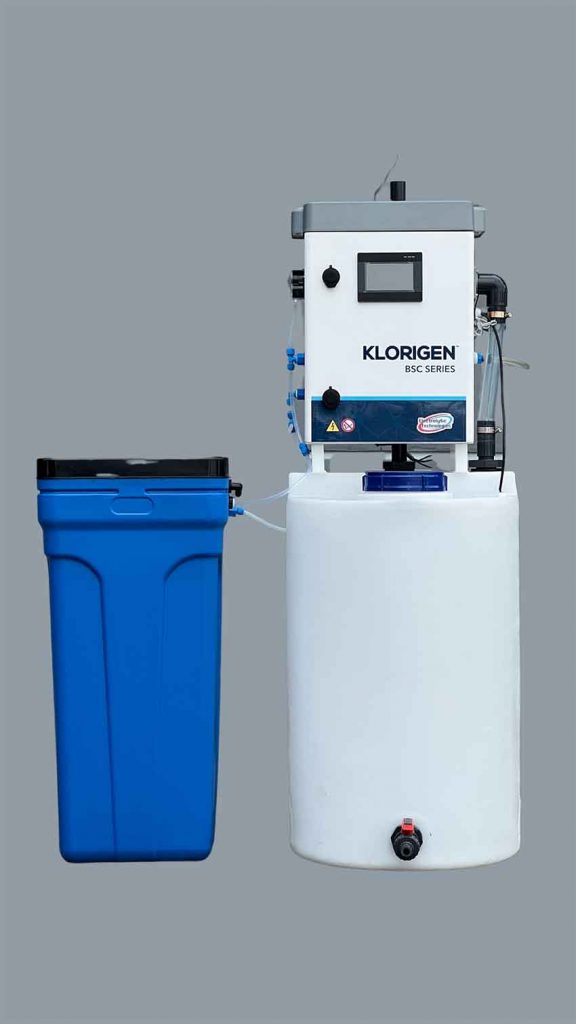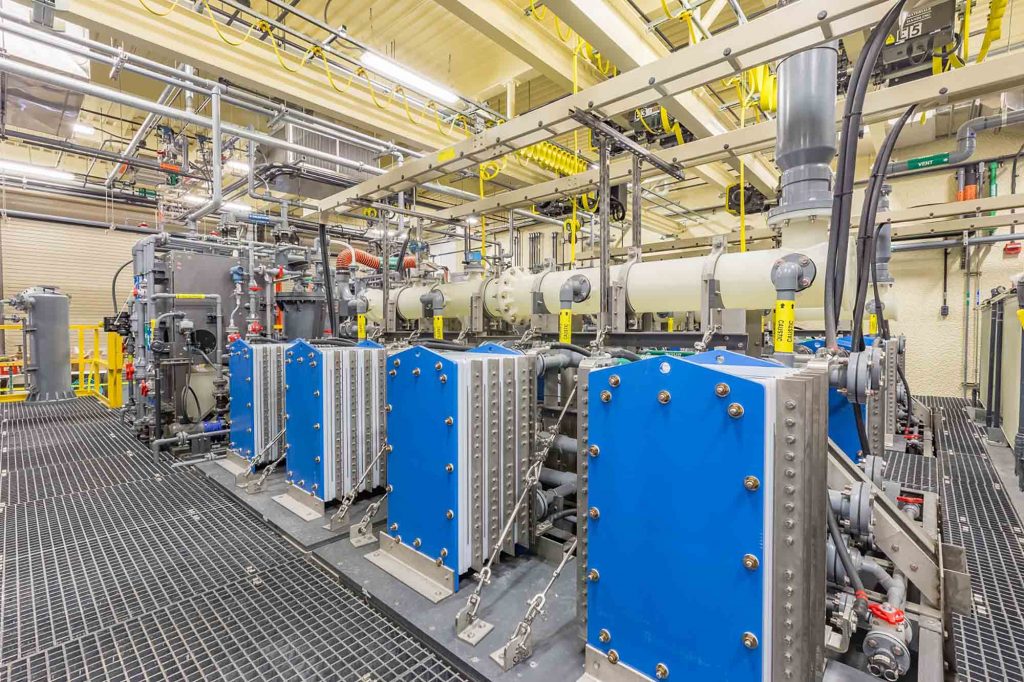Electrolytic Technologies Systems LLC (“ETS”) is a technology, engineering design and fabrication company primarily focused on the on-site generation of chlorine and sodium hypochlorite. ETS was initially formed in 2001 in the USA in Miami, Florida where it continues to maintain its headquarters today. As ETS is a global company with installations in more than 20 countries worldwide; the company maintains satellite offices in Hong Kong, Singapore, Malaysia and South Africa to support its customers.
ETS designs and manufactures on-site electrochemical generators under the trade name “Klorigen™”. Klorigen™ systems allow users of chlorine gas and/or sodium hypochlorite to generate their own product on-site, eliminating their reliance on third-party providers and in particular for users of chlorine gas, eliminating the significant safety hazards associated with the transportation and use of pressurized chlorine gas. With primary inputs of salt, water and electrical power, Klorigen™ systems offer a stable cost-structure and a guaranteed supply in a time of rapid price increases, supply shortages and other market uncertainties that can greatly affect users of chlorine and sodium hypochlorite.
ETS dispatches factory-trained technicians to new installations to provide training for the customer’s operators as well as field-testing and commissioning the Klorigen™ unit. Post-sale, ETS can be contacted 24/7 by customers for technical and operational assistance. ETS considers its users to be its best resource and takes great pride in the level of support that is provided.
As sustainability has become a paramount concern for both new and existing projects, ETS has directed an increased focus to further developing its technology to meet sustainability initiatives. The company’s current research and development priorities are energy-centric, focusing on the implementation of solar power sources to drive the electrolysis process and on the extraction and recovery of hydrogen produced in the process as a potential energy source for Klorigen™ users.
Interview with Sean Laird, Sales Manager at Electrolytic Technologies Systems.
Easy Engineering: What are the main areas of activity of the company?
Sean Laird: Electrolytic Technologies’ Klorigen™ on-site generation technology is designed for users of chlorine and sodium hypochlorite and thus is applicable across several industries including but not limited to water and wastewater treatment, power plants/cooling towers, bleach production and distribution, pulp and paper and many others.
In water and wastewater disinfection applications, Klorigen™ systems allow users to safely generate elemental chlorine gas as needed for “on-demand” disinfection use, eliminating the storage and transportation of pressurized chlorine gas and the significant dangers that it poses to both plant personnel and to nearby communities and those along the supply route. Chlorine gas generated in Klorigen™ systems is applied for disinfection immediately as it is produced, chlorine is never stored in our process. Additionally, operating systems have a minimal amount of chlorine present internally during operation – approximately 1-2 kg per 1,000 kg daily operational capacity. This chlorine is maintained under vacuum and systems contain numerous built-in alarms and safety features to automatically shut down if critical conditions are detected. Chlorine gas systems also generate sodium hydroxide (NaOH or “caustic soda”) as a valuable co-product.

For users of sodium hypochlorite (“bleach”), the chlorine and caustic soda produced in the Klorigen™ electrolyzers can be combined further in the process to produce a high-quality sodium hypochlorite product at up to 15% trade (150 g/L). Sodium hypochlorite is often generated in Klorigen™ systems at costs well-below those of comparable commercially available product. In addition, Klorigen™ systems address the supply concerns that are currently facing chemical users worldwide.
Applications are not limited to municipal water and wastewater utilities. Power plants, mining applications and other industries with effluent treatment responsibilities are also faced with similar concerns, as are industrial users (such as glove manufacturers) whose production processes require the use of chlorine. Commercial sodium hypochlorite distributors seeking to “control their own destiny” and break their reliance on third-party suppliers can also benefit from Klorigen™ on-site generation technology. These chemicals are also used by the medical industry for sterilization and sanitary purposes.
In addition to the manufacture and sale of Klorigen™ systems, ETS also offers a “Build-Own-Operate” program to particularly large-scale chemical users in which ETS will design, manufacture, install and operate the system on the client’s site, providing the final product for sale to the end-user and allowing clients to focus on their core business. . ETS’s Build-Own-Operate program provides users with the “peace of mind” of a long-term reliable supply of these critical chemicals at a stable and predictable cost.
E.E: What’s the news about new products?
S.L: In 2022, ETS launched our BSC-Series (“Brine Self-Cleaning”) on-site generator. In contrast to similar technologies which require the user to periodically acid-wash the cell electrodes to remove deposits that build up over time, the Klorigen™ BSC-50 has been engineered so that the cell electrodes are “self-cleaning”, eliminating the need for acid-washing. BSC-Series systems feature durable electrolysis cells designed for a superior sodium hypochlorite (NaOCl) generation process, using computer optimised flow-paths and highly efficient hydrogen removal outlets in addition to the self-cleaning electrodes.
Like other Klorigen™ models, the BSC-Series system generates NaOCl using water, common salt and DC electricity. Both the anode and the cathode (electrodes) feature high-performance precious metal electrode coating technology, resulting in a reversible electrode cell offering increased NaOCl production compared to similar systems combined with greater power and salt consumption efficiency.

Applications include drinking water, swimming pool water, industrial process water, cooling tower water, remove village water, surface disinfection, and farm water.
E.E: What are the ranges of products?
S.L: ETS’s Klorigen™ systems address the needs of chlorine and sodium hypochlorite users over a wide-range of production demands.
ETS offers two main categories of Klorigen™ systems; one producing chlorine and/or “high-strength” sodium hypochlorite product (up to and exceeding 15% trade or 150 g/L), and the second generating a “low-strength” sodium hypochlorite product at a maximum concentration of 0.8% trade. All Klorigen™ units are modularly constructed for ease of shipping and installation and to allow future expansion to accommodate increased demand, often at a minimal change to total equipment footprint.
“High-strength” generators are the company’s “flagship” product and consist of Klorigen™ “M-Series” and “K-Series” systems. At the heart of these systems are membrane-separated electrolyzers. The membranes separating each anode/cathode electrolyzer cell are positive-ion permeable and result in the generated chlorine being restricted to the anolyte compartments of the cell while positive sodium ions pass through the membrane and form caustic soda in the catholyte cell compartment. This is the key to the system’s performance, as the generated chlorine can be educted directly from the system to the point of use or can be reacted with the caustic under controlled conditions further in the process to produce high-purity sodium hypochlorite. If desired, the system can be designed as a “Hybrid” model which can simultaneously generate all three products.
System production capacities range from 50 kg/day to 250 kg/day chlorine equivalent in the M-Series and from 250 kg/day to well over 20 tons/day in the K-Series units, accommodating the demands of users ranging from small municipalities to large commercial bleach suppliers.
In contrast, “low-strength” units use unseparated electrolyzer cells in which the chlorine and caustic product immediately react to form sodium hypochlorite inside the cell. ETS manufactures both a “B-Series” model that requires a saturated brine feedstock and an “S-Series” model that electrolyzes seawater to produce sodium hypochlorite. The instantaneous reaction limits the concentration of the final product (0.8% in B-Series units and approx. 0.15-0.25% in S-Series units). Benefits of Klorigen™ low-strength generators include a lower capital expenditure, a smaller system footprint and a sodium hypochlorite product that is very safe to handle. These systems are also able to accommodate low production demands, from as little as 5 kg/day chlorine equivalent. Klorigen™ low-strength generators are perfect for smaller applications like well water sites and for remote applications where logistics make sodium hypochlorite delivery problematic. In addition, modular systems can be added as necessary to meet large product demands of over 10 tons/day.
E.E: At what stage is the market where you are currently active?
S.L: Chlorine and sodium hypochlorite have a long-established market; both are hugely important chemicals that are used worldwide. Chlorination has been the primary method of water disinfection for just over 100 years and will likely be the primary method of disinfection 100 years from now. In addition, both chemicals are necessary for a wide variety of manufacturing and industrial processes as well as for sanitation and sterilization purposes.

E.E: What can you tell us about market trends?
S.L: The chemical market, like many others, has been defined by rapid price increases and widespread product unavailability in recent years. The impact on the chlorine and sodium hypochlorite market has likely been exacerbated by the unique challenges when shipping these chemicals; there are many restrictions on chlorine gas shipments due to the associated safety hazards, and sodium hypochlorite degrades over time in relation to temperature. In addition, many large production plants have shut down over the last few years, further decreasing the overall supply. The combination of these factors have caused sodium hypochlorite prices to more than triple for many consumers since 2020. ETS expects the current trends to continue over the foreseeable future.
ETS is uniquely positioned to address these market concerns with its Klorigen™ on-site generation technology. In a world of supply shortages, ETS offers a reliable long-term supply of critical chemicals vital to maintaining clean drinking water around the world. In a market where prices increase rapidly with little warning, ETS offers a stable cost-structure primarily determined by the costs of power and salt. Finally, with on-site production, ETS eliminates the reliance on chlorine and sodium hypochlorite shipments.
E.E: What estimations do you have for 2023?
S.L: ETS expects current trends to continue in 2023, as there is no reason to believe that supply shortages will ease. In the United States, multiple large suppliers of chlor-alkali products (chlorine, caustic soda and sodium hypochlorite) declared force majeures in 2022 and shut down production capacity, further limiting an already depleted supply. The company has spoken with many chemical users who have been notified of future price increases at the expiration of their current supply contract. A few of these users have also mentioned that often when they do receive deliveries, the shipments are refused for contamination or otherwise unsatisfactory conditions. Rapidly rising costs, dwindling supplies and contaminated deliveries appear to be here to stay in 2023.

